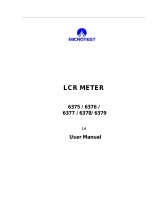OPERATING INSTRUCTIONS
Ground Resistance Measurement
1. Open the jaws and make sure that the mating surfaces are clean and free of dust, dirt or any
foreign substance.
2. Snap the jaws a few times to ensure clean contact is made.
3. Turn the rotary switch to the Ω position to power the instrument on. Do not clamp on to any
conductor or open the jaws, as this is a self-calibration phase.
4. At power on in _ mode, the instrument will perform a self-calibration for optimum accuracy. Users
must wait for self-calibration to be complete before use. During the self-calibration phase, the
LCD will show CAL7, CAL6, CAL5, CAL4, CAL 3, CAL2, and CAL1.
5. When the ground tester is ready, a beep will be heard.
6. Place the clamp around the electrode or ground rod to be measured. Operate the jaws a few
times for better accuracy.
7. Read the value of Rg (ground resistance) from LCD.
NOTE: For better measurement:
1. Operate the jaws a few times before powering on to clear mating surfaces.
2. Do not clamp on to any conductor during power up (point 3 above).
3. Operate the jaws a few times after clamping around the ground electrode.
NOTE: If self-calibration does not complete (The instrument will continue the process until a
successful self-calibration is achieved):
1. Check the jaw mating surfaces. If there is any dirt, dust, or any foreign substance, clean the
surfaces.
2. Ensure the jaws are not open during self-calibration.
NOTE: Noise present in the electrode or ground rod.
If there is excessive current or over 30V noise in the ground rod, a symbol of "NOISE" will be shown
in LCD. Under these conditions, the reading is no longer accurate. We recommend the current flow is
measured before a resistance reading is taken.
NOTE: If jaws are opened during a measurement, a symbol of "OPEN" will be displayed on the LCD.
High and Low Alarm ( )
1. Set the rotary switch to the position.
2. Press the FUNC button to select "HI" or "LO" alarm. The present value of High or Low alarm will
be shown in the lower row of the LCD.
3. Press the
▲ button to increment the value by 1 ohm. If the button is held down, the rate of
increment accelerates. The value can be set from 0 ohm to 1550 ohm and then OL. The value will
roll over to 1(HI) or 0 (LO) if the set value in incremented past OL.
4. Once the value is set, press the FUNC button several times until the upper row LCD does not show
any letters.
6


















